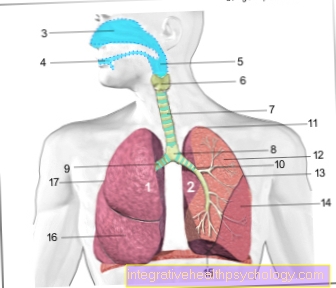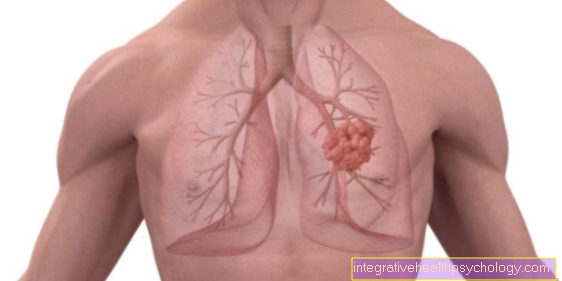Lung cancer
Synonyms
Lung cancer, lung carcinoma, bronchial carcinoma, small cell lung cancer, squamous cell carcinoma, large cell lung cancer, adenocarcinoma, Pancost tumor, NSCLC: Non small cell lung cancer, SCLC: Small cell lung cancer, oat cell cancer
definition
Of the Lung cancer is a malignant mass in the lung, starting from the tissue of the Bronchi.
Different types of lung cancer (Bronchial carcinoma) differentiated. The classification is based on the types of cells that make up the tumor. The different types differ in terms of their frequency, treatment options and prognosis.
Frequencies:
- Squamous cell carcinoma 40-50%
- Small cell lung cancer 25-30%
- Large cell lung cancer 5-10%
- Adenocarcinoma 10-15%
The different therapy options and prognoses are explained under Therapy and prognosis.
The overall cure rate for bronchial carcinoma is still very poor, with a five-year survival rate below ten percent.
Illustration of the lungs

- Right lung -
Pulmodexter - Left lung -
Pulmo sinister - Nasal cavity - Cavitas nasi
- Oral cavity - Cavitas oris
- Throat - Pharynx
- Larynx - larynx
- Windpipe (approx. 20 cm) - Trachea
- Bifurcation of the windpipe -
Bifurcatio tracheae - Right main bronchus -
Bronchus principalis dexter - Left main bronchus -
Bronchus principalis sinister - Lung tip - Apex pulmonis
- Upper lobe - Superior lobe
- Inclined lung cleft -
Fissura obliqua - Lower lobe -
Inferior lobe - Lower edge of the lung -
Margo inferior - Middle lobe -
Lobe medius
(only on the right lung) - Horizontal cleft lung
(between upper and middle lobes on the right) -
Horizontal fissure
You can find an overview of all Dr-Gumpert images at: medical illustrations
Epidemiology
Lung carcinoma, which was a rarity before the 20th century, is now one of the most common types of tumors in humans. For men in Germany, bronchial carcinoma is by far the most common cause of tumor death with a share of 27%. In women, this entity is currently even rarer than malignant breast or intestinal tumors with a proportion of 10% (see Breast cancer / Colon cancer), but in the USA it is already number one. The steadily increasing incidence of lung cancer diagnoses in women is associated with the increasing proportion of female smokers.
The average age of onset is between 55 and 65 years, 5% of the patients are younger than 40 years at the time of diagnosis.
Symptoms

The first symptoms are often:
- chronic cough,
- recurrent or therapy-resistant pneumonia
- Difficulty breathing / shortness of breath
- more breath dependent Chest pain
It is generally said that there are no early symptoms of lung cancer. This means that the first symptoms such as coughing or breathing difficulties e.g. likewise with a normal one cold occur, so are very unspecific. The bronchial carcinoma (Lung cancer) is therefore usually only diagnosed at a very advanced stage; the prognosis deteriorates accordingly.
You can find more information on the topic here: How do you recognize lung cancer?
Note: cough
Lung cancer has a good chance of being cured if the diagnosis is made early. Especially people who have an increased risk of developing lung cancer (e.g. smokers over 40 years of age) should therefore also have a cold With to coughthat lasts longer than three weeks should be checked by a specialist.
Only when the tumor has progressed further, more usually more specific symptoms are added:
- hoarseness
- Cough with bloody sputum
- Pulmonary edema
- Horner syndrome (triad of symptoms from drooping eyelid = ptosis, narrowed pupil = miosis and sunken eyes = enophthalmos)
- Rapid weight loss
- fever
In addition, paraneoplastic syndromes can be observed in small cell bronchial carcinoma. Paraneoplastic syndrome is the term used to describe symptoms that are not triggered directly in the vicinity by the tumor or metastases, but rather result from a remote hormonal effect: the tumor therefore produces substances (hormones) that trigger reactions in other parts of the body.
As a result, it can i.a. to
- An increased level of calcium in the blood (hypercalcaemia)
- a Cushing syndrome
- Muscle weakness of the extremities
etc. come.
A special form of bronchial carcinoma - the so-called Pancost tumor - can also lead to Horner's syndrome and arm swelling.
causes
Many different influences are involved in the development of lung cancer, but there are some factors that increase the personal risk of developing lung cancer. The development of lung cancer is not yet fully understood. As with any cancer development, there is uncontrolled division of cells and unchecked, destructive growth. It is assumed that various changes in the genome of the body cells are the trigger. These changes can e.g. caused by poisons that act on the DNA.
The main risk factors for the development of bronchial carcinoma are inhaled noxae (poisons):
Smoke

Smoke is by far the most important factor; more than 90% of all bronchial carcinomas are the result of cigarette smoking. There are around 40 different cancer-causing substances in tobacco smoke that promote the development of bronchial carcinoma.
The so-called “pack year” is used as the measure of nicotine consumption. A "pack year" means the consumption of 1 pack (corresponding to around 20 cigarettes) per day for a year, for a total of around 7200 cigarettes.
More information on this topic: stop smoking, Smoking diseases,
Consequences of smoking
Risk increasing factors
1-14 cigarettes -> 8-fold
15-24 cigarettes -> 13 times
> 25 cigarettes -> 25 times
The risk also increases the longer a person smokes in their life, and the earlier they start smoking, the higher the risk.
Quitting smoking can clearly reduce the risk. A number of studies show that four to five years after quitting smoking the risk noticeably decreases and after 10 years it approaches the value of non-smokers. If all people stopped smoking, there would be 1/3 less cancer in the world.
You might also be interested in this topic: Pleural mesothelioma
Environmental toxins
Only about 5% of all bronchial carcinomas are triggered by environmental factors.
Carcinogenic substances would be e.g. Asbestos, arsenic and chromium compounds, nickel, polycyclic hydrocarbons (e.g. benzopyrene, which is contained in exhaust gases), quartz dust, etc., as well as radioactive substances, with the gas radon playing the greatest role. It gets into the apartment from the earth through cracks in the masonry or poorly sealed pipes. Measures such as wall sealing or frequent ventilation can reduce radon exposure.
Chronic lung disease
Other risk factors are e.g. Chronic lung diseases such as tuberculosis: what is known as scar carcinoma can develop there from damage to the tissue that has remained.
Genetic factors
If one of the parents becomes ill, the personal risk increases 2-3 times.
Forms of lung cancer
Non-small cell lung cancer (NSCLC)
This includes squamous cell carcinoma, which is mainly located in the center of the lungs and is responsible for almost half of all lung cancer cases. The cancer cells grow less quickly than e.g. in small-cell lung cancer, however, they respond less well to chemotherapy or radiation therapy. Because of the greater separation from the surroundings, an operation is much more likely to be considered.
Adenocarcinoma also belongs to the group of non-small cell bronchial carcinomas. About one in ten lung cancers is of this type. Adenocarcinoma occurs primarily in middle-aged, non-smoking women and therefore has a certain special status.
Large cell lung cancer, which also belongs to this group, occurs relatively rarely (five to ten percent of all malignant lung tumors).
These three types of tumors are grouped under the term non-small-cell lung cancer in order to differentiate them from small-cell lung cancer. In contrast to this, all three tumor types grow more slowly and remain localized for a longer period of time, i.e. they only develop metastases later (squamous cell carcinoma and large cell bronchial carcinoma earlier, adenocarcinoma very late). In all types, metastasis occurs via the lymphatic system in the neighboring lymph nodes, via the blood vessels in the liver, brain, adrenal glands and skeleton (especially in the spine). The desired therapy is always surgery, which is only possible in 1/3 of the patients.
Small cell lung cancer (SCLC)
Small cell lung cancer is also called oat cell cancer because of the similarity of tumor cells with oat grains. It makes approx.1/3 of all bronchial carcinomas and usually occurs in the center of the lungs. Small cell bronchial carcinoma is characterized by its extremely rapid and invasive growth, which leads to metastasis early on.
At this point we would like to refer you to our main page on squamous cell carcinoma of the lung. You will find further important information on this at: Squamous cell carcinoma of the lungs
Note: metastasis
80% of the patients already have an infestation with daughter tumors in other tissues of the body at the initial diagnosis, mostly in the liver or in the brain. This tumor therefore has the worst prognosis.
The therapy of choice is chemotherapy or radiation therapy, which can significantly reduce the size of the tumor, but often relapses. In many cases, small-cell bronchial carcinomas show hormone production as a special feature, which can lead to specific complaints (see paraneoplastic syndrome under symptoms). In addition, they are Chemotherapy side effects not to be neglected.



.jpg)

























